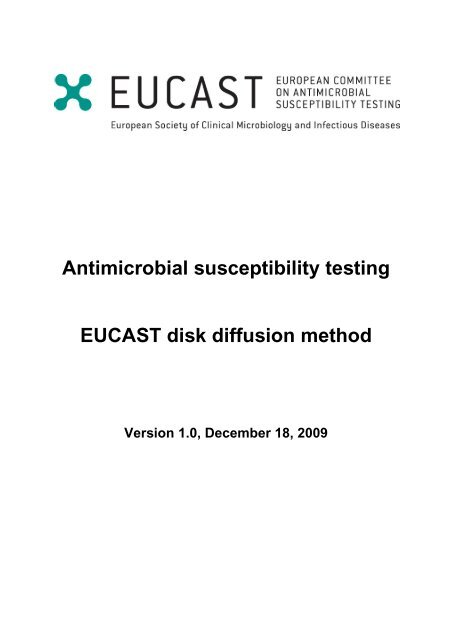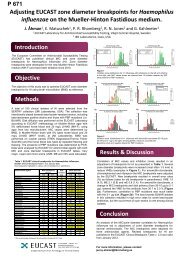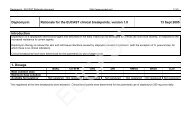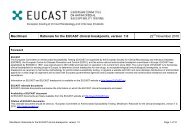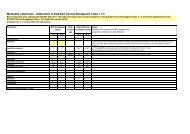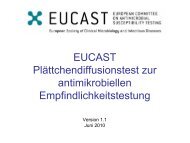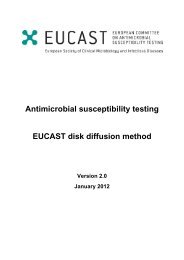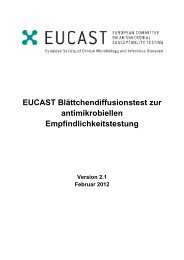Antimicrobial susceptibility testing EUCAST disk diffusion method
Antimicrobial susceptibility testing EUCAST disk diffusion method
Antimicrobial susceptibility testing EUCAST disk diffusion method
Create successful ePaper yourself
Turn your PDF publications into a flip-book with our unique Google optimized e-Paper software.
<strong>Antimicrobial</strong> <strong>susceptibility</strong> <strong>testing</strong><br />
<strong>EUCAST</strong> <strong>disk</strong> <strong>diffusion</strong> <strong>method</strong><br />
Version 1.0, December 18, 2009
Contents<br />
Page<br />
Abbreviations and Terminology<br />
1 Introduction 4<br />
2 Preparation of media 5<br />
3 Preparation of inoculum 6<br />
4 Inoculation of agar plates 8<br />
5 Application of antimicrobial <strong>disk</strong>s 9<br />
6 Incubation of plates 10<br />
7 Examination of plates after incubation 11<br />
8 Measurement of zones and interpretation of <strong>susceptibility</strong> 12<br />
9 Quality control 13<br />
Document amendments<br />
Version Amendment Date<br />
1.0 First edition December 18, 2009<br />
<strong>EUCAST</strong> Disk Diffusion Method for <strong>Antimicrobial</strong> Susceptibility Testing ‐ Version 1.0 (Dec 2009)<br />
www.eucast.org<br />
2
Abbreviations and terminology<br />
ATCC<br />
BLNAR<br />
CCUG<br />
CIP<br />
DSM<br />
ESBL<br />
<strong>EUCAST</strong><br />
MH<br />
American Type Culture Collection<br />
http://www.atcc.org<br />
ß-Lactamase negative, ampicillin resistant<br />
Culture Collection Universtity of Göteborg<br />
http://www.ccug.se<br />
Collection de Institut Pasteur<br />
http://www.cabri.org/CABRI/srs-doc/cip_bact.info.html<br />
Bacterial cultures from Deutsche Stammsammlung für Mikroorganismen und<br />
Zellkulturen (DSMZ) have DSM numbers<br />
http://www.dsmz.de/index.htm<br />
Extended spectrum β-lactamase<br />
European Committee on <strong>Antimicrobial</strong> Susceptibility Testing<br />
http://www.eucast.org<br />
Mueller-Hinton agar<br />
MH-F Mueller-Hinton agar -fastidious organisms (MH supplemented with 5%<br />
defibrinated horse blood and 20 mg/L β-NAD)<br />
MRSA<br />
NCTC<br />
ß-NAD<br />
Saline<br />
Methicillin resistant Staphylococcus aureus (with mecA gene)<br />
National Collection of Type Cultures<br />
http://www.hpacultures.org.uk<br />
ß-Nicotinamide adenine dinucleotide<br />
A solution of 0.85% NaCl in water<br />
<strong>EUCAST</strong> Disk Diffusion Method for <strong>Antimicrobial</strong> Susceptibility Testing ‐ Version 1.0 (Dec 2009)<br />
www.eucast.org<br />
3
1 Introduction<br />
Disk <strong>diffusion</strong> is one of the oldest approaches to antimicrobial <strong>susceptibility</strong> <strong>testing</strong><br />
and remains one of the most widely used antimicrobial <strong>susceptibility</strong> <strong>testing</strong><br />
<strong>method</strong>s in routine clinical laboratories. It is suitable for <strong>testing</strong> the majority of<br />
bacterial pathogens, including the more common fastidious bacteria, is versatile in<br />
the range of antimicrobial agents that can be tested and requires no special<br />
equipment.<br />
In common with several other <strong>disk</strong> <strong>diffusion</strong> techniques, the <strong>EUCAST</strong> <strong>method</strong> is a<br />
standardised <strong>method</strong> based on the principles defined in the report of the<br />
International Collaborative Study of <strong>Antimicrobial</strong> Susceptibility Testing, 1972, and<br />
the experience of expert groups worldwide.<br />
The zone diameter breakpoints in the <strong>EUCAST</strong> <strong>method</strong> are calibrated to the<br />
harmonised European breakpoints that are published by <strong>EUCAST</strong> and are freely<br />
available from the <strong>EUCAST</strong> website (http://www.eucast.org).<br />
As with all <strong>method</strong>s, the described technique must be followed without modification<br />
in order to produce reliable results.<br />
<strong>EUCAST</strong> Disk Diffusion Method for <strong>Antimicrobial</strong> Susceptibility Testing ‐ Version 1.0 (Dec 2009)<br />
www.eucast.org<br />
4
2 Preparation of media<br />
2.1 Prepare MH agar according to the manufacturer’s instructions, with supplementation<br />
for fastidious organisms as indicated in Table 1.<br />
2.2 Medium should have a level depth of 4 mm ± 0.5 mm (25 mL in a 90 mm Petri dish,<br />
70 mL in a 150 mm Petri dish).<br />
2.3 The surface of the agar should be dry before use. Whether plates require drying and<br />
the length of time needed to dry the surface of the agar depends on storage and<br />
drying conditions. Do not over-dry plates.<br />
2.4 Store plates prepared in-house at 8-10°C. If plates are stored for longer than 7 days,<br />
consider storing plates at 4-8°C in sealed plastic bags.<br />
2.5 For plates prepared in-house, plate drying, storage conditions and shelf life should<br />
be determined as part of the laboratory quality assurance programme.<br />
2.6 Commercially prepared plates should be stored as recommended by the<br />
manufacturer and used within the labelled expiry date.<br />
Table 1<br />
Media for antimicrobial <strong>susceptibility</strong> <strong>testing</strong><br />
Organism<br />
Enterobacteriaceae<br />
Pseudomonas spp.<br />
Stenotrophomonas maltophilia<br />
Acinetobacter spp.<br />
Staphylococcus spp.<br />
Enterococcus spp.<br />
Streptococcus pneumoniae<br />
Streptococcus Groups A, B, C and G<br />
Other streptococci<br />
Haemophilus spp.<br />
Moraxella catarrhalis<br />
Medium<br />
MH agar<br />
MH agar<br />
MH agar<br />
MH agar<br />
MH agar<br />
MH agar<br />
MH agar + 5% defibrinated horse blood+ 20 mg/L NAD (MH‐F)<br />
MH agar + 5% defibrinated horse blood+ 20 mg/L NAD (MH‐F)<br />
MH agar + 5% defibrinated horse blood+ 20 mg/L NAD (MH‐F)<br />
MH agar + 5% defibrinated horse blood+ 20 mg/L NAD (MH‐F)<br />
MH agar + 5% defibrinated horse blood+ 20 mg/L NAD (MH‐F)<br />
Other fastidious organisms<br />
Pending<br />
<strong>EUCAST</strong> Disk Diffusion Method for <strong>Antimicrobial</strong> Susceptibility Testing ‐ Version 1.0 (Dec 2009)<br />
www.eucast.org<br />
5
3 Preparation of inoculum<br />
3.1 Use the direct colony suspension <strong>method</strong> to make a suspension of the organism in<br />
saline to the density of a McFarland 0.5 turbidity standard (Table 2), approximately<br />
corresponding to 1-2 x10 8 CFU/mL for Escherichia coli.<br />
The direct colony suspension <strong>method</strong> is appropriate for all organisms, including<br />
fastidious organisms such as Haemophilus spp., Moraxella catarrhalis,<br />
Streptococcus pneumoniae, β-haemolytic and other streptococci.<br />
3.1.1 Make the suspension from overnight growth on non-selective medium. Use<br />
several morphologically similar colonies (when possible) to avoid selecting<br />
an atypical variant and suspend the colonies in saline with a sterile loop or a<br />
cotton swab.<br />
3.2 Standardise the inoculum suspension to the density of a McFarland 0.5 standard. A<br />
denser inoculum will result in reduced zones of inhibition and a decreased inoculum<br />
will have the opposite effect.<br />
3.2.1 It is recommended that a photometric device is used to adjust the density of<br />
the suspension to McFarland 0.5. The photometric device must be calibrated<br />
against a McFarland standard according to the manufacturer’s instruction.<br />
3.2.2 Alternatively, the density of the suspension can be compared visually to a<br />
0.5 McFarland turbidity standard.<br />
Vigorously agitate the turbidity standard on a vortex mixer before use.<br />
To aid comparison, compare the test and standard against a white<br />
background with black lines.<br />
3.2.3 Streptococcus pneumoniae is preferably suspended from a blood agar plate<br />
to McFarland 0.5. When Streptococcus pneumoniae is suspended from a<br />
chocolate agar plate, the inoculum must be equivalent to McFarland 1.0.<br />
3.2.4 Adjust the density of the organism suspension to McFarland 0.5 by adding<br />
saline or more organisms.<br />
3.3 The suspension should optimally be used within 15 min and always within 60 min of<br />
preparation.<br />
<strong>EUCAST</strong> Disk Diffusion Method for <strong>Antimicrobial</strong> Susceptibility Testing ‐ Version 1.0 (Dec 2009)<br />
www.eucast.org<br />
6
Table 2<br />
Preparation of McFarland 0.5 turbidity standard<br />
1 Add 0.5 mL of 0.048 mol/L BaCl 2 (1.175% w/v BaCl 2·2H 2 0) to 99.5 mL of 0.18<br />
mol/L (0.36 N) H 2 S0 4 (1% v/v) and mix thoroughly.<br />
2 Check the density of the suspension in a spectrophotometer with a 1 cm light<br />
path and matched cuvettes. The absorbance at 625 nm should be in the range<br />
0.08 to 0.13.<br />
3 Distribute the suspension into tubes of the same size as those used for test<br />
inoculum adjustment. Seal the tubes.<br />
4 Store sealed standards in the dark at room temperature.<br />
5 Mix the standard thoroughly on a vortex mixer immediately before use.<br />
6 Renew standards or check their absorbance after storage for 6 months.<br />
7 Prepared standards purchased from commercial sources should be checked to<br />
ensure that absorbance is within the acceptable range.<br />
<strong>EUCAST</strong> Disk Diffusion Method for <strong>Antimicrobial</strong> Susceptibility Testing ‐ Version 1.0 (Dec 2009)<br />
www.eucast.org<br />
7
4 Inoculation of agar plates<br />
4.1 Optimally, use the adjusted inoculum suspension within 15 min of preparation.<br />
4.2 Dip a sterile cotton swab into the suspension and remove the excess fluid by turning<br />
the swab against the inside of the container.<br />
It is important to remove excess fluid from the swab to avoid over-inoculation of<br />
plates, particularly for Gram-negative organisms.<br />
4.3 Spread the inoculum evenly over the entire surface of the plate by swabbing in three<br />
directions or by using an automatic plate rotator.<br />
4.4 Apply <strong>disk</strong>s within 15 minutes.<br />
If inoculated plates are left at room temperature for prolonged periods of time before<br />
the <strong>disk</strong>s are applied, the organism may begin to grow, resulting in erroneous<br />
reduction in sizes of zones of inhibition. Disks should therefore be applied to the<br />
surface of the agar within 15 min of inoculation.<br />
<strong>EUCAST</strong> Disk Diffusion Method for <strong>Antimicrobial</strong> Susceptibility Testing ‐ Version 1.0 (Dec 2009)<br />
www.eucast.org<br />
8
5 Application of antimicrobial <strong>disk</strong>s<br />
5.1 The required <strong>disk</strong> contents are listed in the breakpoint and quality control tables at<br />
http://www.eucast.org.<br />
5.2 Apply <strong>disk</strong>s firmly to the surface of the inoculated and dried agar plate. The contact<br />
with the agar must be close and even. Disks must not be moved once they have<br />
been applied to plates as <strong>diffusion</strong> of antimicrobial agents from <strong>disk</strong>s is very rapid.<br />
5.3 The number of <strong>disk</strong>s on a plate should be limited so that unacceptable overlapping of<br />
zones is avoided. The maximum number of <strong>disk</strong>s depends on the organism and the<br />
agents tested as some agents consistently give larger zones than others with<br />
susceptible isolates. No more than six <strong>disk</strong>s can be accommodated on a 90 mm<br />
circular plate or 12 on a 150 mm circular plate.<br />
5.4 Loss of potency of antimicrobial agents in <strong>disk</strong>s results in reduced zone diameters<br />
and is a common source of error. The following are essential:<br />
5.4.1 Store <strong>disk</strong>s, including those in dispensers, in sealed containers with a<br />
desiccant and protected from light (some agents, including metronidazole,<br />
chloramphenicol and the quinolones, are inactivated by prolonged exposure<br />
to light).<br />
5.4.2 Store <strong>disk</strong> stocks at -20°C unless otherwise indicated by the supplier. If this is<br />
not possible, store <strong>disk</strong>s at
6 Incubation of plates<br />
6.1 Invert plates and incubate them within 15 min of <strong>disk</strong> application. If the plates are left<br />
at room temperature after <strong>disk</strong>s have been applied, pre-<strong>diffusion</strong> may result in<br />
erroneously large zones of inhibition.<br />
6.2 Stacking plates in the incubator affects results owing to uneven heating of plates.<br />
The efficiency of incubators varies and therefore the control of incubation, including<br />
appropriate numbers of plates in stacks, should be determined as part of the<br />
laboratory’s quality assurance programme.<br />
6.3 Incubate plates in the conditions shown in Table 3.<br />
6.4 With glycopeptide <strong>susceptibility</strong> tests on some strains of Enterococcus spp. resistant<br />
colonies are not visible until plates have been incubated for a full 24h. However,<br />
plates may be examined after 16-20h and any resistance reported, but plates of<br />
isolates appearing susceptible must be re-incubated and reread at 24h.<br />
Table 3<br />
Organism<br />
Enterobacteriaceae<br />
Pseudomonas spp.<br />
Stenotrophomonas maltophilia<br />
Acinetobacter spp.<br />
Staphylococcus spp.<br />
Enterococcus spp.<br />
Streptococcus pneumoniae<br />
Incubation conditions for antimicrobial <strong>susceptibility</strong><br />
test plates<br />
Streptococcus Groups A, B, C and G<br />
Other streptococci<br />
Haemophilus spp.<br />
Moraxella catarrhalis<br />
Incubation conditions<br />
35±1°C in air for 16‐20 h<br />
35±1°C in air for 16‐20 h<br />
35±1°C in air for 16‐20 h<br />
35±1°C in air for 16‐20 h<br />
35±1°C in air for 16‐20 h<br />
35±1°C in air for 16‐20 h<br />
(35±1°C in air for 24 h for glycopeptides)<br />
35±1°C in 4‐6% CO 2 in air for 16‐20 h<br />
35±1°C in 4‐6% CO 2 in air for 16‐20 h<br />
35±1°C in 4‐6% CO 2 in air for 16‐20 h<br />
35±1°C in 4‐6% CO 2 in air for 16‐20 h<br />
35±1°C in 4‐6% CO 2 in air for 16‐20 h<br />
Other fastidious organisms<br />
Pending<br />
<strong>EUCAST</strong> Disk Diffusion Method for <strong>Antimicrobial</strong> Susceptibility Testing ‐ Version 1.0 (Dec 2009)<br />
www.eucast.org<br />
10
7 Examination of plates after incubation<br />
7.1 A correct inoculum and satisfactorily streaked plates should result in a confluent lawn<br />
of growth.<br />
7.2 The growth should be evenly distributed over the plate to achieve uniformly circular<br />
(non-jagged) inhibition zones.<br />
7.3 If individual colonies can be seen, the inoculum is too light and the test must be<br />
repeated.<br />
7.4 Check that inhibition zones are within quality control limits.<br />
<strong>EUCAST</strong> Disk Diffusion Method for <strong>Antimicrobial</strong> Susceptibility Testing ‐ Version 1.0 (Dec 2009)<br />
www.eucast.org<br />
11
8 Measurement of zones and interpretation of <strong>susceptibility</strong><br />
8.1 For all agents, the zone edge should be read at the point of complete inhibition as<br />
judged by the naked eye.<br />
8.2 Measure the diameters of zones of inhibition to the nearest millimetre with a ruler,<br />
calliper or an automated zone reader.<br />
8.3 Read un-supplemented plates from the back with reflected light and the plate held<br />
above a dark background.<br />
8.4 Read supplemented plates from the front with the lid removed and with reflected light.<br />
8.5 Read linezolid <strong>susceptibility</strong> tests on staphylococci from the back with the plate held up<br />
to light (transmitted light).<br />
8.6 When using cefoxitin for the detection of methicillin resistance in Staphylococcus<br />
aureus, measure the obvious zone, and examine zones carefully in good light to detect<br />
colonies within the zone of inhibition. These may be either a contaminating species or<br />
the expression of heterogeneous methicillin resistance.<br />
8.7 Discreet colonies growing within the zone of inhibition should be sub-cultured and<br />
identified and the test repeated if necessary.<br />
8.8 For Proteus spp., ignore swarming and read inhibition of growth.<br />
8.9 Antagonists in the medium may result in faint growth up to the <strong>disk</strong> within sulphonamide<br />
or trimethoprim zones. Such growth should be ignored and the zone diameter measured<br />
at the more obvious zone edge.<br />
8.10 For haemolytic streptococci on MH-F medium, read inhibition of growth and not<br />
inhibition of haemolysis.<br />
8.11 Interpret zone diameters by reference to breakpoint tables at http://www.eucast.org.<br />
8.12 If templates are used for interpreting zone diameters, the plate is placed over the<br />
template and zones interpreted according to the <strong>EUCAST</strong> breakpoints marked on the<br />
template. A program for preparation of templates is freely available from<br />
http://www.bsac.org.uk/<strong>susceptibility</strong>_<strong>testing</strong>/bsac_disc_<strong>diffusion</strong>_template_program.cfm<br />
<strong>EUCAST</strong> Disk Diffusion Method for <strong>Antimicrobial</strong> Susceptibility Testing ‐ Version 1.0 (Dec 2009)<br />
www.eucast.org<br />
12
9 Quality control<br />
9.1 Use specified control strains (table 4) to monitor the performance of the test.<br />
Principal recommended control strains are typical susceptible strains, but resistant<br />
strains can also be used to confirm that the <strong>method</strong> will detect resistance mediated<br />
by known resistance mechanisms (table 5). These strains may be purchased from<br />
culture collections or from commercial sources.<br />
9.2 Store control strains under conditions that will maintain viability and organism<br />
characteristics. Storage on glass beads at -70°C in glycerol broth (or commercial<br />
equivalent) is a convenient <strong>method</strong>. Non-fastidious organisms can be stored at<br />
-20°C. Two vials of each control strain should be stored, one as an in-use supply and<br />
the other as an archive for replenishment of the in-use vial when required.<br />
9.3 Each week subculture a bead from the in-use vial on to appropriate non-selective<br />
media and check for purity. From this pure culture, prepare one subculture on each<br />
day of the week. For fastidious organisms that will not survive on plates for five to six<br />
days, subculture the strain daily for no more than one week.<br />
9.4 Acceptable ranges for control strains are shown in <strong>EUCAST</strong> Quality Control Tables.<br />
9.5 Use the recommended routine quality control strains to monitor test performance.<br />
Control tests should be set up and checked daily, at least for antibiotics which are<br />
part of routine panels.<br />
Each day that tests are set up, examine the results of the last 20 consecutive tests.<br />
Examine results for trends and for zones falling consistently above or below the<br />
mean. If two or more of 20 tests are out of range investigation is required.<br />
See <strong>EUCAST</strong> document “Quality assurance of antimicrobial <strong>susceptibility</strong> <strong>testing</strong>” for<br />
further details.<br />
9.6 Control strains should be tested daily until performance is shown to be satisfactory<br />
(no more than 1 in 20 tests outside control limits), at which stage <strong>testing</strong> frequency<br />
may be reduced to once a week. If performance standards are not met, the cause<br />
must be investigated.<br />
9.7 In addition to routine QC <strong>testing</strong>, test each new batch of Mueller-Hinton agar to<br />
ensure that all zones are within range.<br />
Aminoglycoside <strong>disk</strong>s may disclose unacceptable variation in divalent cations in the<br />
medium, tigecycline may disclose variation in magnesium, trimethoprimsulfamethoxazole<br />
will show up problems with the thymine content, erythromycin can<br />
disclose an unacceptable pH.<br />
<strong>EUCAST</strong> Disk Diffusion Method for <strong>Antimicrobial</strong> Susceptibility Testing ‐ Version 1.0 (Dec 2009)<br />
www.eucast.org<br />
13
Table 4:<br />
Quality control organisms for routine <strong>testing</strong><br />
Organism Strain Characteristics<br />
Escherichia coli ATCC 25922<br />
NCTC 12241<br />
CIP 7624<br />
DSM 1103<br />
CCUG 17620<br />
Pseudomonas aeruginosa ATCC 27853<br />
NCTC 12934<br />
CIP 76110<br />
DSM 1117<br />
CCUG 17619<br />
Staphylococcus aureus ATCC 29213<br />
NCTC 12973<br />
CIP 103429<br />
DSM 2569<br />
CCUG 15915<br />
Enterococcus faecalis ATCC 29212<br />
NCTC 12697<br />
CIP 103214<br />
DSM 2570<br />
CCUG 9997<br />
Streptococcus pneumoniae ATCC 49619<br />
NCTC 12977<br />
CIP 104340<br />
DSM 11967<br />
CCUG 66368<br />
Haemophilus influenzae NCTC 8468<br />
CIP 54.94<br />
CCUG 23946<br />
Susceptible, wild-type<br />
Susceptible, wild-type<br />
Weak β-lactamase producer<br />
Susceptible, wild-type<br />
Low-level chromosomally mediated<br />
penicillin resistant<br />
Susceptible, wild type<br />
<strong>EUCAST</strong> Disk Diffusion Method for <strong>Antimicrobial</strong> Susceptibility Testing ‐ Version 1.0 (Dec 2009)<br />
www.eucast.org<br />
14
Table 5:<br />
Additional quality control organisms for detection of<br />
specific resistance mechanisms<br />
Organism Strain Characteristics<br />
Escherichia coli ATCC 35218<br />
NCTC 11954<br />
CIP 102181<br />
DSM 5564<br />
CCUG 30600<br />
TEM-1 ß-lactamase, ampicillin resistant<br />
Staphylococcus aureus NCTC 12493 mecA-positive, hetero-resistant MRSA<br />
Haemophilus influenzae ATCC 49247<br />
NCTC 12699<br />
CIP 104604<br />
DSM 9999<br />
CCUG 26214<br />
ß-lactamase negative, ampicillin resistant<br />
(BLNAR)<br />
<strong>EUCAST</strong> Disk Diffusion Method for <strong>Antimicrobial</strong> Susceptibility Testing ‐ Version 1.0 (Dec 2009)<br />
www.eucast.org<br />
15
<strong>EUCAST</strong> Disk Diffusion Method for <strong>Antimicrobial</strong> Susceptibility Testing ‐ Version 1.0 (Dec 2009)<br />
www.eucast.org<br />
16


